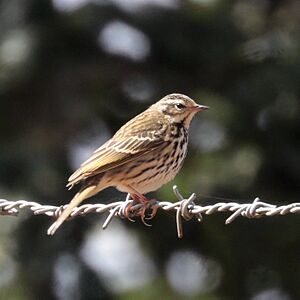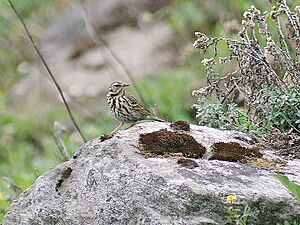Olive-backed pipit facts for kids
Quick facts for kids Olive-backed pipit |
|
|---|---|
 |
|
| A. h. hodgsoni Mount Phulchowki, Nepal |
|
| Conservation status | |
| Scientific classification |
The olive-backed pipit (Anthus hodgsoni) is a small passerine bird that belongs to the pipit family. It's known for its beautiful olive-green back. These birds live and breed in many parts of Asia, including southern, central, and eastern areas, and even in north-eastern European Russia. When winter comes, they fly long distances to warmer places like southern Asia and Indonesia.
Sometimes people call this bird the Indian pipit or Hodgson's pipit. It looks a bit like the tree pipit, but its back is more olive-colored and has fewer streaks. Its head also looks different, with a clearer stripe above its eye.
The name Anthus comes from Latin. It was used for a small bird that lived in grasslands. The second part of its scientific name, hodgsoni, honors an English diplomat and collector named Brian Houghton Hodgson.
Contents
Where Does the Olive-Backed Pipit Live?
The olive-backed pipit lives in different places depending on the season.
Summer Homes
During summer, these birds can be found:
- From the Himalayas in Pakistan and India, west through Nepal.
- Into China, as far north as Gansu province.
- East through Korea to Japan.
- North through central Asia into north-eastern Europe (European Russia).
They can breed high up in the mountains, sometimes as high as 4,500 meters in eastern Nepal. Sometimes, they are rarely seen in western Europe.
Winter Travels
In winter, they travel to a wide southern region across Asia. This includes:
- Peninsular India.
- East to Southeast Asia.
- The Philippines.
What Kind of Habitat Do They Like?
These birds prefer open areas. In winter, they live in evergreen forests. In summer, they like groves and wooded areas.
What Does the Olive-Backed Pipit Look Like?
The olive-backed pipit is about the size of a sparrow, around 15 centimeters long.
Appearance
- Its back is greenish-brown with darker brown streaks.
- It has a whitish stripe above its eye (called a supercilium).
- It has two whitish bars on its wings.
- The outer tail feathers are also whitish.
- Its belly is whitish to buff-colored.
- It has dark brown streaks on its chest and sides.
- Male and female birds look the same.
Habits
You usually see these birds alone or in pairs. They run around on the ground looking for food. If something scares them, they fly up into trees. Their flight is a bit jerky and goes up and down.
Calls and Songs
Their song sounds like a lark's song and is sung while flying. It's similar to the tree pipit's song but faster and higher-pitched. They also make a single tseep or spek sound, which is also like the tree pipit.
What Do They Eat?
Olive-backed pipits mainly eat insects. They will also eat grass and weed seeds.
Reproduction
The olive-backed pipit's breeding season is from May to July.
Nests and Eggs
- They build a cup-shaped nest using moss and grass.
- The nest is placed on the ground, often hidden under a clump of grass or a large rock.
- They prefer open woodlands and scrub areas for nesting.
- Female pipits usually lay 3 to 5 eggs, most often 4.
- The eggs are dark brown with darker spots.
- These birds usually raise two groups of chicks each year.



